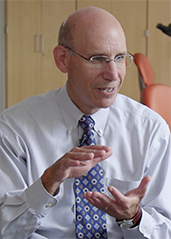This issue of Into Practice is adapted from Instructional Moves content produced by the Teaching and Learning Lab at the Harvard Graduate School of Education.
 Dr. Richard Schwartzstein, Ellen and Melvin Gordon Professor of Medicine and Medical Education, is revolutionizing textbook-dependent classrooms by incorporating real-life applications. In this case, first-year Harvard Medical School students apply their reading through case simulations. A robot functions as the patient, and a small group of students take on various roles to work together and treat the patient. Students are supported by a facilitator, who offers guiding questions but no direct answers, as well as the rest of the class, who serve as consultants or in other supporting roles in the case, like the patient’s family. “Instead of a paper case, now it feels much more real. And suddenly, they’re immersed in taking care of a patient,” Dr. Schwartzstein reflects. After a simulation ends, the whole class debriefs the case, including what students struggled with and how they felt during the exercise.
Dr. Richard Schwartzstein, Ellen and Melvin Gordon Professor of Medicine and Medical Education, is revolutionizing textbook-dependent classrooms by incorporating real-life applications. In this case, first-year Harvard Medical School students apply their reading through case simulations. A robot functions as the patient, and a small group of students take on various roles to work together and treat the patient. Students are supported by a facilitator, who offers guiding questions but no direct answers, as well as the rest of the class, who serve as consultants or in other supporting roles in the case, like the patient’s family. “Instead of a paper case, now it feels much more real. And suddenly, they’re immersed in taking care of a patient,” Dr. Schwartzstein reflects. After a simulation ends, the whole class debriefs the case, including what students struggled with and how they felt during the exercise.